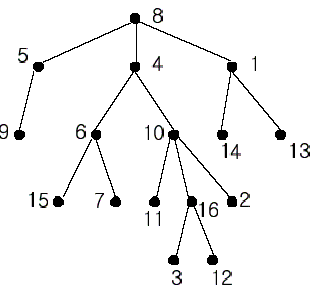lca入门———树上倍增法(博文内含例题)
倍增求LCA:
father【i】【j】表示节点i往上跳2^j次后的节点
可以转移为
father【i】【j】=father【father【i】【j-1】】【j-1】
整体思路:
先比较两个点的深度,如果深度不同,先让深的点往上跳,浅的先不动,等两个点深度一样时,if 相同 直接返回,if 不同 进行下一步;如果不同,两个点一起跳,j从大到小枚举(其实并不大),如果两个点都跳这么多后,得到的点相等,两个点都不动(因为有可能正好是LCA也有可能在LCA上方),知道得到的点不同,就可以跳上来,然后不断跳,两个点都在LCA下面那层,所以再跳1步即可,当father【i】【j】中j=0时即可,就是LCA,返回值结束
(摘自http://blog.csdn.net/dad3zz)
在网络海洋中搜寻很久后找到hzwer的宽搜求deep序,进行了学习。
以下是我的模板代码:
构造访问数组!
void make_bin()
{
bin[0]=1;
for(int i=1;i<=15;i++)
bin[i]=bin[i-1]<<1;
}
简明易懂邻接表!
void Link()
{
for(int i=1;i<=n-1;i++){//n-1 edges;or you can define a m pointing to the number of edges;
scanf("%d%d",&u[i],&v[i]);
u[i+n-1]=v[i];v[i+n-1]=u[i];//双向;
next[i]=first[u[i]];
next[i+n-1]=first[v[i]];//双向;
first[u[i]]=i;
first[v[i]]=i+n-1;//双向;
isroot[v[i]]=true;
}
}
宽搜!
void bfs()
{
int head=0,tail=1;
q[0]=root,vis[root]=true;
while(head^tail){
int now=q[head];head++;
for(int i=1;i<=15;i++){
if(bin[i]<=deep[now])
fa[now][i]=fa[fa[now][i-1]][i-1];
else break;
}
for(int i=first[now];i;i=next[i])
if(!vis[v[i]]){
vis[v[i]]=true;
fa[v[i]][0]=now;
deep[v[i]]=deep[now]+1;
q[tail++]=v[i];
}
}
}
求lca()
int lca(int x,int y)
{
if(deep[x]<deep[y])swap(x,y);
int t=deep[x]-deep[y];
for(int i=0;i<=15;i++)
if(t&bin[i])x=fa[x][i];
for(int i=15;i>=0;i--)
if(fa[x][i]^fa[y][i])
x=fa[x][i],y=fa[y][i];
if(!(x^y))return y;
return fa[x][0];
}
之后,在poj上找了一个众所周知的例题,poj1330,当做lca入门题
| Time Limit: 1000MS | Memory Limit: 10000K | |
| Total Submissions: 24757 | Accepted: 12864 |
Description

In the figure, each node is labeled with an integer from {1, 2,...,16}. Node 8 is the root of the tree. Node x is an ancestor of node y if node x is in the path between the root and node y. For example, node 4 is an ancestor of node 16. Node 10 is also an ancestor
of node 16. As a matter of fact, nodes 8, 4, 10, and 16 are the ancestors of node 16. Remember that a node is an ancestor of itself. Nodes 8, 4, 6, and 7 are the ancestors of node 7. A node x is called a common ancestor of two different nodes y and z if node
x is an ancestor of node y and an ancestor of node z. Thus, nodes 8 and 4 are the common ancestors of nodes 16 and 7. A node x is called the nearest common ancestor of nodes y and z if x is a common ancestor of y and z and nearest to y and z among their common
ancestors. Hence, the nearest common ancestor of nodes 16 and 7 is node 4. Node 4 is nearer to nodes 16 and 7 than node 8 is.
For other examples, the nearest common ancestor of nodes 2 and 3 is node 10, the nearest common ancestor of nodes 6 and 13 is node 8, and the nearest common ancestor of nodes 4 and 12 is node 4. In the last example, if y is an ancestor of z, then the nearest
common ancestor of y and z is y.
Write a program that finds the nearest common ancestor of two distinct nodes in a tree.
Input
labeled with integers 1, 2,..., N. Each of the next N -1 lines contains a pair of integers that represent an edge --the first integer is the parent node of the second integer. Note that a tree with N nodes has exactly N - 1 edges. The last line of each test
case contains two distinct integers whose nearest common ancestor is to be computed.
Output
Sample Input
2
16
1 14
8 5
10 16
5 9
4 6
8 4
4 10
1 13
6 15
10 11
6 7
10 2
16 3
8 1
16 12
16 7
5
2 3
3 4
3 1
1 5
3 5
Sample Output
4
3
Source
Source Code
| Problem: 1330 | User: ksq2013 | |
| Memory: 1224K | Time: 32MS | |
| Language: C++ | Result: Accepted |
ac代码如下:
#include<cstdio>
#include<cstring>
#include<iostream>
using namespace std;
bool vis[10100],isroot[10100];
int root,q[10100],deep[10100],fa[10100][20];
int n,bin[20],first[10100],next[10100],u[10100],v[10100];
void make_bin()
{
bin[0]=1;
for(int i=1;i<=15;i++)
bin[i]=bin[i-1]<<1;
}
void Link()
{
for(int i=1;i<=n-1;i++){
scanf("%d%d",&u[i],&v[i]);
//u[i+n-1]=v[i];v[i+n-1]=u[i];
next[i]=first[u[i]];
//next[i+n-1]=first[v[i]];
first[u[i]]=i;
//first[v[i]]=i+n-1;
isroot[v[i]]=true;
}
for(int i=1;i<=n;i++)
if(!isroot[i]){
root=i;
break;
}
}
void bfs()
{
int head=0,tail=1;
q[0]=root,vis[root]=true;
while(head^tail){
int now=q[head];head++;
for(int i=1;i<=15;i++){
if(bin[i]<=deep[now])
fa[now][i]=fa[fa[now][i-1]][i-1];
else break;
}
for(int i=first[now];i;i=next[i])
if(!vis[v[i]]){
vis[v[i]]=true;
fa[v[i]][0]=now;
deep[v[i]]=deep[now]+1;
q[tail++]=v[i];
}
}
}
int lca(int x,int y)
{
if(deep[x]<deep[y])swap(x,y);
int t=deep[x]-deep[y];
for(int i=0;i<=15;i++)
if(t&bin[i])x=fa[x][i];
for(int i=15;i>=0;i--)
if(fa[x][i]^fa[y][i])
x=fa[x][i],y=fa[y][i];
if(!(x^y))return y;
return fa[x][0];
}
int main()
{
make_bin();
int T;
scanf("%d",&T);
for(;T;T--){
memset(vis,false,sizeof(vis));
memset(isroot,false,sizeof(isroot));
memset(q,0,sizeof(q));
memset(fa,0,sizeof(fa));
memset(deep,0,sizeof(deep));
memset(first,0,sizeof(first));
memset(next,0,sizeof(next));
scanf("%d",&n);
Link();
bfs();
int x,y;
scanf("%d%d",&x,&y);
printf("%d\n",lca(x,y));
}
return 0;
}
lca入门———树上倍增法(博文内含例题)的更多相关文章
- 最近公共祖先算法LCA笔记(树上倍增法)
Update: 2019.7.15更新 万分感谢[宁信]大佬,认认真真地审核了本文章,指出了超过五处错误捂脸,太尴尬了. 万分感谢[宁信]大佬,认认真真地审核了本文章,指出了超过五处错误捂脸,太尴尬了 ...
- 树上倍增法求LCA
我们找的是任意两个结点的最近公共祖先, 那么我们可以考虑这么两种种情况: 1.两结点的深度相同. 2.两结点深度不同. 第一步都要转化为情况1,这种可处理的情况. 先不考虑其他, 我们思考这么一个问题 ...
- 【37.48%】【hdu 2587】How far away ?(3篇文章,3种做法,LCA之树上倍增)
Time Limit: 2000/1000 MS (Java/Others) Memory Limit: 32768/32768 K (Java/Others) Total Submission(s) ...
- LCA离线Tarjan,树上倍增入门题
离线Tarjian,来个JVxie大佬博客最近公共祖先LCA(Tarjan算法)的思考和算法实现,还有zhouzhendong大佬的LCA算法解析-Tarjan&倍增&RMQ(其实你们 ...
- Codeforces 609E (Kruskal求最小生成树+树上倍增求LCA)
题面 传送门 题目大意: 给定一个无向连通带权图G,对于每条边(u,v,w)" role="presentation" style="position: rel ...
- HDU 2586 倍增法求lca
How far away ? Time Limit: 2000/1000 MS (Java/Others) Memory Limit: 32768/32768 K (Java/Others)To ...
- 最近公共祖先 LCA 倍增法
[简介] 解决LCA问题的倍增法是一种基于倍增思想的在线算法. [原理] 原理和同样是使用倍增思想的RMQ-ST 算法类似,比较简单,想清楚后很容易实现. 对于每个节点u , ancestors[u] ...
- 最近公共祖先 LCA (Lowest Common Ancestors)-树上倍增
树上倍增是求解关于LCA问题的两个在线算法中的一个,在线算法即不需要开始全部读入查询,你给他什么查询,他都能返回它们的LCA. 树上倍增用到一个关键的数组F[i][j],这个表示第i个结点的向上2^j ...
- 【bzoj4940】[Ynoi2016]这是我自己的发明 DFS序+树上倍增+莫队算法
题目描述 给一个树,n 个点,有点权,初始根是 1. m 个操作,每次操作: 1. 将树根换为 x. 2. 给出两个点 x,y,从 x 的子树中选每一个点,y 的子树中选每一个点,如果两个点点权相等, ...
随机推荐
- Office 365 – SharePoint 2013 Online 中添加域和域名
1.在SharePoint Online管理中心,点击菜单上的添加域,如下图: 2.进入管理域的页面,点击添加域来添加我们自己的域名,如下图: 3.进入“在 Office 365中添加新域”的向导,跟 ...
- Emacs学习心得之 基础配置
作者:枫雪庭 出处:http://www.cnblogs.com/FengXueTing-px/ 欢迎转载 Emacs学习心得之 基础配置 1.前言2.基础配置 一.前言 本篇博文记录了Emacs的一 ...
- SharePoint:WebPartPageUserException This page has encountered a critical error
遇到如下webpart莫名错误,很常见吧.一般用户是直接删掉,知道原因的不算太多. 解决办法(Solution): Usually, This error caused by wrong entrie ...
- OC中的面向对象语法4
一. 继承 1. 继承的基本用法 l 设计两个类Bird.Dog // Bird的声明 @interface Bird : NSObject { @public int weight; } - (vo ...
- iOS中的小知识点
1.tableView隐藏滚动条 self.tableView.showsVerticalScrollIndicator = NO; 2.关于属性 使用assign: 对基础数据类型 (NSI ...
- 1.5 基础知识——GP2.3 提供资源(Resources) 与 GP2.4 分配职责(Responisbility)
摘要: 没有资源和落实权责,将无法做好事情,这是很多公司很多人都懂的道理.但很多做CMMI改进的公司,号称很多核心人员负责过程改进,其实是兼职挂牌而已,有些甚至招聘应届生作为过程改进的主力…… 如此这 ...
- 10个关于Java异常的常见问题
这篇文章总结了十个经常被问到的JAVA异常问题: 1.检查型异常VS非检查型异常 简单的说,检查型异常是指需要在方法中自己捕获异常处理或者声明抛出异常由调用者去捕获处理: 非检查型异常指那些不能解决的 ...
- JavaScript Patterns 6.7 Borrowing Methods
Scenario You want to use just the methods you like, without inheriting all the other methods that yo ...
- ORACLE AWR报告数据的导入导出实践
关于AWR的快照数据可以导出.导入,一直没有亲手实践过.今天动手测试了一下如何导出.导入AWR数据,将AWR的数据从一测试服务器,导入到另外一台测试服务器. SQL> @?/rdbms/admi ...
- Linux umount设备时出现device is busy解决方法
在Linux中,有时使用umount命令去卸载LV或文件时,可能出现umount: xxx: device is busy的情况,如下案例所示 [root@DB-Server u06]# vgdisp ...
